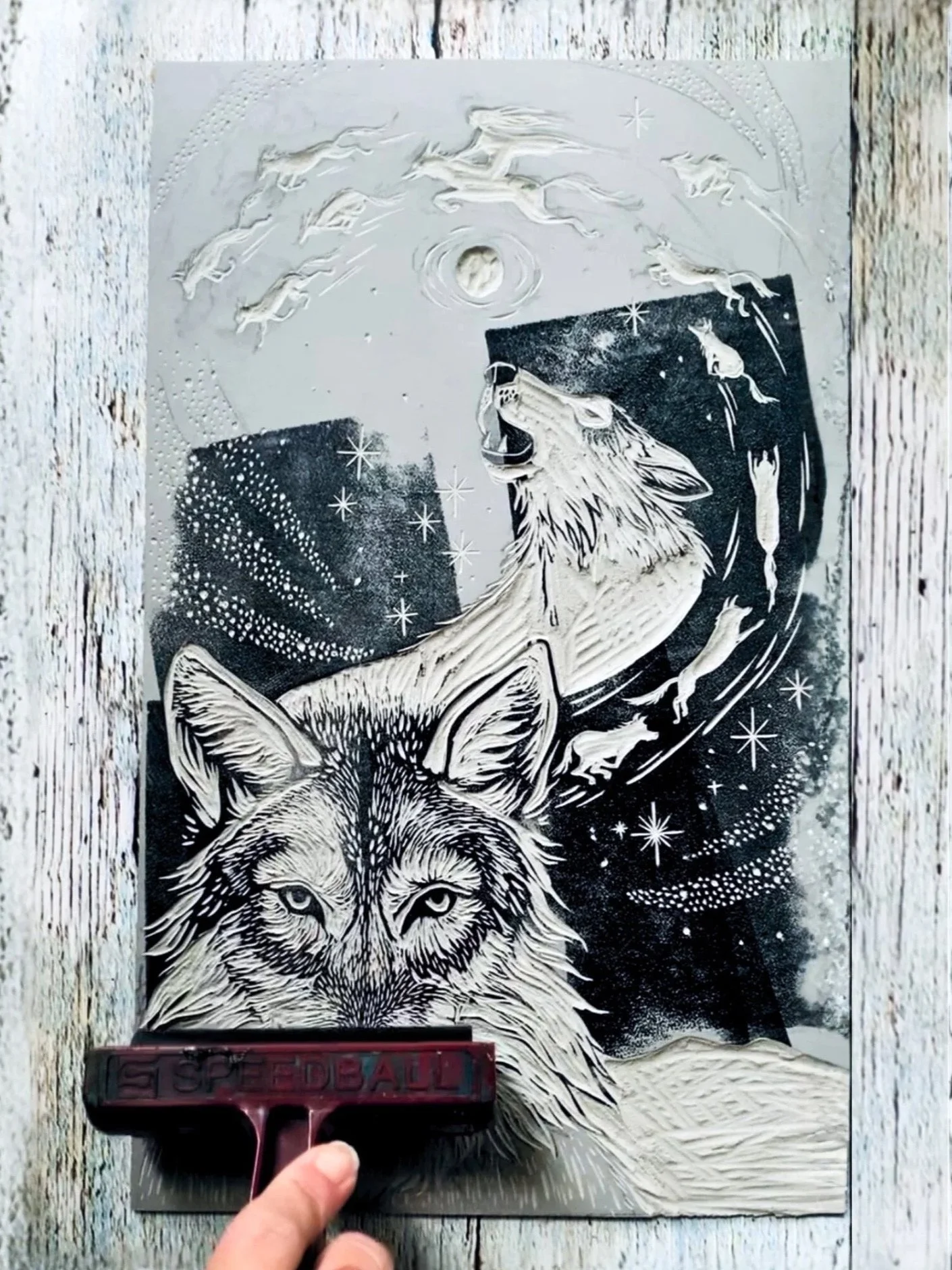Rolling black ink onto this carved block of linoleum to reveal an image of a wolf howling, and in the background waiting to be inked is a woman riding a wolf jumping over a full moon. Inspired by Jiang Rong’s Wolf Totem, this print honors the Mongolian sheepherders’ belief in wolves as keepers of wisdom who teach the living how to survive the harsh grassland climate, and sacred spirits who guide dead to their otherworldly home in the skies.
What is the purpose and significance of color in printmaking? What secret meaning whispers beneath what we might first behold?
A scientist might analyze color in terms of pigments and light, describing how certain wavelengths strike the retina and activate specific cells that let us perceive difference. A functional anthropologist or archeologist might add onto this explanation observing that early humans choose colors for practical and utilitarian purposes to ensure their own survival. From these vantage points we might imagine that pigments were drawn from the very soil, stone, and berries that surrounded them, shaped to mark identity and belonging, define roles, and claim territory—all gestures that carried the quiet weight of evolutionary advantage.
But I want to look at color from another perspective, because these explanations, while true, feel incomplete. Color is never only chosen for material or pragmatic reasons. People have always traveled great distances, spent fortunes, suffered and even risked survival itself, in search of a particular shade. What deeper motivation might be behind these choices? Color must be so much more than a chemical or optical effect, otherwise why would some colors move us so deeply emotionally, or compel us to put in so much extra labor into creating them beyond necessity or survival? I would like to reflect upon this question through the history and lense of the first printmaking inks, their creation and use in China which date back to 700 A.D. because I think through this historical frame we discover something fascinating about color, its meaning in human life then and what value this might offer us today.
A beautiful video of traditional Chinese ink making is available on instagram at rabias_world1. Here in this image are the lamps that traditionally are used to burn down the pine wood resin to make the soot needed to make the ink. Watch the video its really fascinating as it shows the whole process from start to finish in a couple of minutes!
The Diamond Sutra, as described in previous blog posts, was and is the first print ever made (1). Handprinted entirely in black ink on a mulberry paper scroll, it records the Buddha’s sacred words with delicate images of the Buddha himself alongside his attendants, framed by a border consisting of symbolic motifs of clouds, waves and lotus petals. It was discovered in 1900 sealed up within a hidden chamber of the Mogao caves on the edge of the Gobi Desert. What might it mean that the world’s first printed text was a spiritual one, created not for commerce but for contemplation? And why was it rendered in black ink? What secret power did it hold that warranted such careful keeping? This post explores the deeper significance of that choice of color, and how black ink itself becomes a vessel for meaning.
At first glance, Chinese black ink (sometimes also called India Ink) seems ordinary. It is made from the soot of pine wood and bound with animal glue derived from horn or hide. But beyond the practical availability of the materials needed to make it lies a deeper more complex story. Far beyond simply a fashionable color, the color black carried deep and multifaceted significance.
In the ancient Chinese worldview, black carried meaning, mystery, and power. Rooted in the cosmology of the Five Elements, black was aligned with water, the north, and winter—linking it with cycles of depth, flow, and endurance. Within the philosophy of yin and yang, black symbolised the receptive, mysterious, and hidden principle of yin, complementary to white (yang), the active and visible force. In Taoist terms, black was the origin, the “unmanifested” from which all things emerge—an indicator of potential, emptiness, and primordial un‑being. Lao Tzu, the legendary Chinese sage and founder of Taoism, wrote in the Tao Te Ching: “Know the white, yet keep to the black; be a model for the world.” His words speak of a cosmos born of balance, where light and darkness breathe each other into being. Each contains the seed of the other, a sacred cycle in which shadow gives rise to light, and light nourishes shadow.
From this cosmic principle, black took on the status of “king of colors” in ancient China and was linked to authority, knowledge, immortality, and power. For example, during the Qin Dynasty (221 BC–206 BC), black was adopted as the imperial color because the dynasty associated itself with the element of water and thus with the north and winter. The first emperor, Qin Shi Huang, wore a black dragon‑robe and instituted black as the color for his dynasty’s flags, robes, and official dress to assert his sovereignty and alignment with cosmic order. In short, black in ancient China was far more than a pigment—its use was an expression of dynastic place in the cosmos, a visual embodiment of cosmological alignment as well as spiritual depth, authority, and connection to the mystery that precedes creation.
Clockwise from left top: the process of 1) collecting resin from a tree, 2) storing the resin in bamboo, 3) preparing the resin to be burned 4) burning the resin to make soot 5) scraping the soot from the lamp 6) a thick grey liquid which is the ink. You can watch this process on instagram @rabias_world1
However, it is in the heart of the ancient Chinese myth of a legendary hero named Xuanwu that the color black reveals its deepest symbolic power. Whispered through the centuries by bards, mystics, monks and folk storytellers, the tale of Xuanwu tells of a mortal man, wrestling with the shadows of his own psyche: caution and ambition, desire and restraint, fear and courage, complacency and responsibility warring within him. He was haunted by these tensions of everyday life, and driven by a hunger for wholeness, he abandoned the familiar and ventured into the frozen north, embarking on a solitary initiation. There, stripped of illusion and tested in the crucible of his inner world, he became apprentice to silence, meditation, to shadow, to the cold truths hidden within himself.
In the stillness of that wilderness, his dual nature began to fuse. Comfort and challenge, security and freedom, conformity and authenticity—once in conflict—now found harmony. At last, his heart stilled. Transcending the torments of his mortal mind Xuanwu transformed into celestial form and became the Black Turtle and Serpent, entwined in eternal embrace across the northern night sky, embodying the breath of yin and yang. The Black Turtle bears the weight of the world, steadfast and enduring; the Serpent coils with the pulse of life, vibrant and flowing. In their union, mortal struggle becomes immortal myth, and shadow and light are forever entwined.
Thus in this mythic realm, black becomes more than a color—it becomes one partner in an eternal mythic dance between two opposites and the origin of life itself. This is also revealed in the I Ching, one of the oldest texts and oracles in Taoist philosophy, where black is the color of the Tao, the primordial womb from which all things arise and to which they return. It is the river beneath the surface, the fertile dark that receives and renews, the mother of all colors—the mystery that makes creation, story, and spirit possible.
The traditional Huizhou inkstick is considered one of China’s national heritages. This enduring black ink is stored dry as a stick and is reawakened with water. Creating it requires eleven steps and is entirely done by hand. These ink sticks can be dated to the Tang (618-907) and Song (960-1279) dynasties. Photo courtesy of rabias_world1 on instagram - the video is fascinating!
Seen in this light, it becomes clear black was a color often used not merely for convenience or aesthetic preference, but to resonate with cosmic order and satisfy a profound psychological need for balance and meaning. Given this context, it makes so much more sense that the choice of black for the Diamond Sutra was profoundly symbolic — the color was an invocation of the Tao, the hidden, the infinite. Black ink did more than record sacred words; it carried the essence of the mystery those words sought to name, complementing and augmenting its wisdom.
This idea finds its echo in the very alchemy of black ink’s creation. While soot and ash might be gathered with ease, the process of creating the finest black ink demanded an artistry that was almost sacred. Ink artisans burned not only pine resin but sometimes also yeast from wine fermentation, powdered rhinoceros horn, pearl, and jasper to name a few hard to find ingredients. They tended funnel-shaped lamps through the night, scraping the rising soot with delicate feathers to capture only the purest essence. Cloves, honey, and musk would be added to the recipe to mask the earthly odors of binders sometimes drawn from yak skin and fish intestines. Each step was an apprenticeship in patience and devotion, transforming raw elements of destruction into a black as deep as night itself—a vessel of shadow, memory, and wisdom. In the hands of a scholar or monk, this ink was not merely pigment, but a bridge from the world of matter to the realm of spirit, a symbol of refinement, endurance, and the eternal pursuit of knowledge. The original recipe for Chinese ink endured and remained largely unchanged - even the invention of the printing press in the 19th century had little impact on it. You can catch a glimpse of the process of creating traditional Chinese Huizhou inksticks in the photos provided on this page and also on instagram @rabias_world1.
In traditional Chinese scholarship, the act of creating with ink - whether painting, calligraphy or printmaking - was never merely practical. It was a ritual steeped in symbolism and reverence. The Four Treasures of the Study—the brush, the ink, the paper, and the inkstone—are vessels of transformation. The brush, shaped from hair and bamboo, channels thought and spirit into form. The ink, made from soot and ash, embodies the alchemy of turning elements of destruction into creation, of shadow into story. The paper receives and cradles these gestures, a fertile void awaiting creation. Together, they remind us that every stroke is a passage between worlds: from the raw, elemental materials of the earth to the mythic realm of imagination and meaning. These art forms were not just technical skills but spiritual acts. In Chinese brush painting (2), artists used varying shades of black (from deep black to pale gray washes) to depict vast landscapes and express a harmony between humanity and nature, reflecting Taoist and scholarly ideals of simplicity and introspection. The nuanced use of black ink was a key method for capturing the essence and vitality of a subject. In printmaking, too, black ink was also used to replicate sacred texts for widespread distribution (3).
If on paper black transforms raw materials into vision and spirit, in the architecture of a home it transforms space itself—guiding energy, inviting introspection, and anchoring life’s flow. Feng Shui is the enduring Chinese practice of cultivating wellbeing through the artful arrangement of color, furniture, and natural elements in a home or workplace in order to channel chi, or the animating energy of a place. In the context of this tradition that still is used in modern homes today, the color black introduces depth and a sense of infinity to a room. It is used to as a protective color to anchor and absorb excess or chaotic energy reminding inhabitants to stay rooted, focused and calm even while navigating change. Black is associated with the water element of adaptability and transformation, and when used thoughtfully, it encourages emotional flexibility, helping dissolve both psychological blockages and physical spacial stagnation ensuring energy circulates smoothly. Black is also thought to nourish wisdom and intuition, opening channels to deeper knowing, creativity and spiritual awareness. Finally, black clarifies and defines a room and can lend a space a sense of quiet authority. When placed near the entrance or in a workspace, it communicates confidence, self-assurance, awakens opportunity and advancement, channeling energy toward career growth especially when positioned near entrances or in the north. Because of its powerful, absorbing nature, Feng Shui practitioners use black with intention and balance, tempering its depth with lighter tones or reflective materials so that its energy remains vital rather than heavy.
According to the ancient Chinese practice of Feng Shui, used in moderation, black provides contrast that enhances all other colors. It clarifies and defines a space, allowing other elements to shine more vividly. Black can lend a space a sense of quiet authority. When placed near an entrance, window or in a workspace, it communicates confidence, self-assurance, and the ability to move through uncertainty with grace. It is the color of flow, not stagnation—the still water that mirrors the sky, holding both mystery and clarity at once.
Though black ink dominated the art of printmaking for generations, and is the focus of this exploration, the palette of Chinese printmaking gradually widened as the centuries unfolded, encompassing vibrant hues. Chinese printmakers of the later Ming and Qing dynasties began to create new colors: vermilion (born of mercury and sulfur), yellow (from arsenic sulfide), blue (from azurite), green (from malachite or jade powder), white (from pearl), and gold and silver (wrought from delicate metal foils). Many of these pigments were toxic and difficult to obtain and create, yet artisans continued to produce them despite the risks—driven less by practicality than by devotion to each color’s place within a larger cosmological order. Each of these pigments, in fact, could warrant its own story which extends beyond the scope of this post.
What I hope emerges is a deeper sense of black’s sacred significance—revealed when we view it through a lens that weaves mythology, psychology, history, and culture. That black was chosen to print the world’s first known text—a story of the Buddha’s awakening—feels far from mere practicality and coincidence. It is as if the color itself were part of the teaching, a conduit for meaning. Black was not absence, but origin—the fertile darkness from which light, form, and understanding are born. Perhaps, in essence, color is more than light reflected—it is the language through which matter itself speaks to the soul.
The color black introduces depth and a sense of infinity to a room. Black is the color of the Tao, the primordial womb from which all things arise and to which they return. To choose black is to stand once more at the edge of the unknown, to trust the Mother of all colors in Her creative process - not in the glare of certainty - but in the cradle of darkness and mystery.
In the West, we have often cast the dark aside as shadow or evil. However, this is only one truth in a paradox because on the other side of the looking glass, black is also the womb from which every seed is nourished. As Clark Strand writes in Waking Up to the Dark: The Black Madonnas Gospel for an Age of Extinction and Collapse, “Darkness is not the absence of light but its cradle.” To awaken in the dark, he writes, is to return to the night, to that maternal hour when creation first stirred before the world was bombarded with electric lights and the quest to find answers illuminated in the brightness only. In this view, black and darkness is not something to be overcome, but something to be entered - we can expect to discover something precious there. Like the “Great Mother” whom Strand evokes—Isis, Kali, the Black Madonna—black is her robe, the womb of the cosmos, the night sky of becoming, the sacred depth in which every spark of light is conceived. In choosing black, consciously or unconsciously, we step into that original field. To print in black, to clothe in black, to meditate upon black is to stand once more at the edge of creation, to enter the unknown willingly—to trust the mystery.
Note 1 The sutra is called the “Diamond Sutra” because its wisdom “will cut like a diamond blade through worldly illusion to illuminate what is real and everlasting,” a phrase recited within the text itself.
Note 2 This mirrors the later European medieval monastic practice, where the act of writing sacred texts and prayers was considered a spiritual ritual in itself, not merely a practical task.
Note 3 Black ink has also held a devotional significance in Islamic tradition. The Arabic word for ink, midād (مِداد), is closely related to the concept of divine substance or matter, and it appears in the Quran in reference to the words of God. Beyond soot and water, black ink was often enhanced with substances such as saffron, Tibetan musk, and hemp oil to imbue it with spiritual potency. As Khadi Ahmad, author of a historic black ink recipe, wrote: “The Ink of the Scholar is more holy than the blood of the martyr.”
References:
Le Guin, Ursula K. (1998). Lao Tzu Tao Te Ching: A Book About the Way and the Power of the Way. Shambhala.
“Making Chinese Inksticks: A Brief Exploration” Kitchen Studio Factory: Making in East Asia. Retrieved Nov. 6, 2025.
Muszycka, Martha., Allen-Roberts, Rhiannon., and Moore, Samantha (March 26.2022). “The Diamond Sutra: The Earliest Printed Book.” StoryMaps, Esri, 2023. Retrieved Nov. 6, 2025.
St. Clair, Kassia. The Secret Lives of Color. Penguin Publishing Group, 2017.
“The Art of Chinese Traditional Wood‑block Printing: History and Customs.” Hong Kong Heritage Museum, Heritage Museum Services, 2024. Retrieved Nov. 6, 2025.










